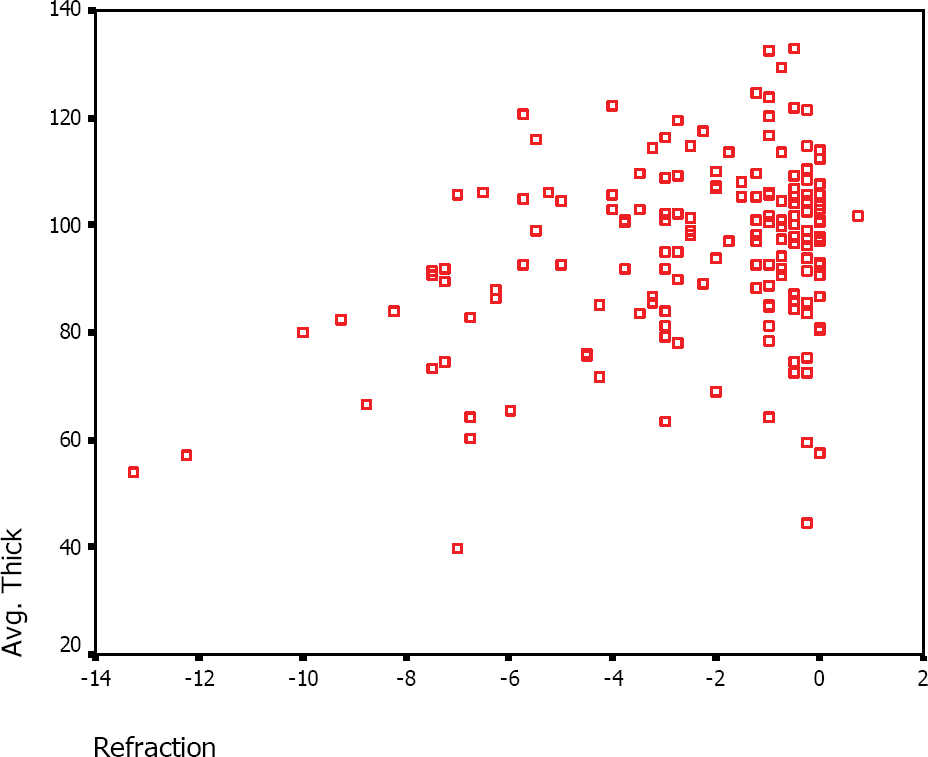1. Quigley HA, Katz J, Derrick RJ. . An evaluation of optic disc and nerve fiber layer examinations in monitoring progression of early glaucoma damage. Ophthalmology. 1992; 99:19–28.

2. Sommer HA, Quigley HA, Robin AL. . Evaluation of nerve fiber layer assessment. Arch Ophthalmol. 1984; 102:1766–71.

3. Quigley HA, Addicks EM, Green WR. Optic nerve damage in human glaucoma. Arch Ophthalmol. 1982; 100:135–46.

4. Hyung SM, Kim DM, Hong C, Youn DH. Optic Disc of the Myopic Eye: Relationship between Refractive Errors and Morphometric Characteristics. Korean J Ophthalmol. 1992; 6:32–5.

5. Curtin BJ, Karlin DB. Axial length measurements and fundus changes of the myopic eye. Am J Ophthalmol. 1971; 1:42–53.

6. Yanoff M, Fine BS. Ocular pathology: A text and atlas. 3rd ed. Philadelphia: JB Lippincott;1989. p. 408.
7. Tomlinson A, Philips CI. Ratio of optic cup to optic disc in relation to axial length of eyeball and refraction. Br J Ophthalmol. 1969; 53:765.

8. Daubs JG, Crick RP. Effect of refractive error on the risk of ocular hypertension and open angle glaucoma. Trans Ophthal Soc U K. 1981; 101:121.
9. Perkins ES, Phelps CD. Open angle glaucoma, ocular hypertension, low-tension glaucoma, and refraction. Arch Ophthalmol. 1982; 100:1464.

10. Phelps CD. Effects of myopia on prognosis in treated primary open-angle glaucoma. Am J Ophthalmol. 1982; 93:622.
11. Curtin BJ. The Myopias. Philadelphia: Harper & Row;1985. p. 159–269.
12. Jonas JB, Gusek GC, Naumann GOH. Optic disk morphometry in high myopia. Graefe’s Arch Clin Exp Ophthalmol. 1988; 226:587.

13. Johnstone MA. Ritch R, Shields MB, Krupin T, editors. Primary open-angle glaucoma. The Glaucomas. 1st ed. St. Louis: C. V. Mosby;1989. v.2:p. chap. 35.
14. Huang D, Swanson EA, Lin CP. . Optical coherence tomography. Science. 1991; 254:1178–81.

15. Hee MR, Izatt JA, Swanson EA. . Optical coherence tomography of the human retina. Arch Ophthalmol. 1995; 113:325–32.

16. Budenz DL, Michael A, Chang RT. . Sensitivity and Specificity of the Stratus OCT for perimetric Glaucoma. Ophthalmology. 2005; 112:3–9.
17. Malgorzata M, Bakunowice-Lazarczuk A, Sredzmskn-Kita D. Use of optical coherence tomography in myopia. J Pediatr Ophthalmol Strabismus. 2004; 41:159–62.

18. Weinreb RN. Evaluating the retinal nerve fiber layer in glaucoma with scanning laser polarimetry. Arch Ophthalmol. 1999; 117:1403–6.

19. Morgan JE, Waldock A, Jeffery G, Cowey A. Retinal nerve fiber layer polarimetry: histological and clinical comparison. Br J Ophthalmol. 1998; 82:684–90.
20. Niessen AG, Van Den Berg TJ, Langerhorst CT, Greeve EL. Retinal nerve fiber layer assessment by scanning laser polarimetry and standarded photography. Am J Ophthalmol. 1996; 121:484–93.
21. Tjon-Fo-Sang MJ, Lemij HG. The sensitivity and specificity of nerve fiber measurements in glaucoma as determined with scanning laser polarimetry. Am J Ophthalmol. 1997; 123:62–9.
22. Zhou Q, Weinreb RN. Individualized compensation of anterior segment birefringence during scanning laser polarimetry. Invest Ophthalmol Vis Sci. 2002; 43:2221–8.
23. Weinreb RN, Bowd C, Zangwill LM. Glaucoma detection using scanning laser polarimetry with variable corneal polarization compensation. Arch Ophthalmol. 2003; 121:218–24.

24. Greenfield DS, Knighton RW, Huang XR. Effect of corneal polarization axis on assessment of retinal nerve fiber layer thickness by scanning laser polarimetry. Am J Ophthalmol. 2000; 129:715–22.

25. Park MH, Hwang HS, Moon JI. Diagnosis of Glaucoma in the cases of the opposed Results of GDx and OCT. J Korean Ophthalmol Soc. 2005; 46:2010–5.
26. Choi SW, Lee SJ. Thickness Changes in the Fovea and Peripapillary Retinal Nerve Fiber Layer Depend on the Degree of Myopia. Korean J Ophthalmol. 2006; 20:215–9.

27. Bowd C, Medeiros FA, Weinreb RN, Zangwill LM. The Effect of Atypical Birefringence Patterns on Glaucoma Detection Using Scanning Laser Polarimetry with Variable Corneal Compensation. Invest Ophthalmol Vis Sci. 2007; 48:223–7.

28. Leung CK, Mohamed S, Leung KS. . Retinal nerve Fiber Layer Measurements in Myopia: An Optical Coherence Tomography Study. Invest Ophthalmol Vis Sci. 2006; 47:5171–6.

29. Ozdek SC, Onol M, Gürelik G, Hasanreisoglu B. Scanning laser polarimetry in normal subjects and patients with myopia. Br J Ophthalmol. 2000; 84:264–7.

30. Kremmer S, Zadow T, Steuhl KP, Selbach JM. Scanning laser polarimetry in myopic and hyperopic subjects. Graefes Arch Clin Exp Ophthalmol. 2004; 242:489–94.

31. Salchow DJ, Oleynikov YS, Chiang MF. . Retinal nerve fiber layer thickness in normal children measured with optical coherence tomography. Ophthalmology. 2006; 113:786–91.

32. Bowd C, Zangwill LM, Blumenthal EZ. . Imaging of the optic disc and retinal nerve fiber layer: the effects of age, optic disc area, refractive error, and gender. J Opt Soc Am A Opt Image Sci Vis. 2002; 19:197–207.

33. Hoh ST, Lim MC, Seah SK. . Peripapillary retinal nerve fiber layer thickness variations with myopia. Ophthalmology. 2006; 113:773–7.

34. Bozkurt B, Irkec M, Gedik S. Effect of peripapillary chorioretinal atrophy on GDx parameters in patients with degenerative myopia. Clin Exp Ophthalmol. 2002; 30:411–4.

35. Mitchell P, Hourihan F, Sandbach J, Wang JJ. The relationship between glaucoma and myopia: the Blue Mountains Eye Study. Ophthalmology. 1999; 106:2010–15.
36. Grodum K, Heijl A, Bengtsson B. Refractive error and glaucoma. Acta Ophthalmol Scand. 2001; 79:560–6.





 PDF
PDF ePub
ePub Citation
Citation Print
Print


 XML Download
XML Download